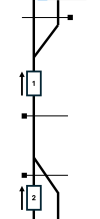I'm jumping in to ask something a bit different, but more or less consistent with the thread title. With conventional semaphore signalling, absolute block (or permissive block for slow freight trains) was normal for two-track lines but not for single-track, hence the need for token/tablet/staff. The West Highlind line now has RETB, which is a modern equivalent. But trains on modern bi-directional tracks are controlled by the same systems as on unidirectional tracks. Why do those lines not need anything additional?
The use of additional controls such as staff and ticket for single lines actually dates from before the Absolute Block system. The time interval system used previously couldn't work on single lines, because any signalman could send a train forward on their own initiative, subject only to the elapsed time since the last train. Something more was needed to prevent trains being sent in from both ends of a single line at the same time.
Absolute Block relies on the actions of the signalmen to ensure there is only one train in a section. This reliance was reduced by various extra controls over the years but still remains, particularly because there's nothing to stop the signalman giving train out of section without observing the tail lamp or indeed the train itself. On a double track, if two trains are somehow allowed into the same section, the first one may keep ahead and avoid any collision, or if collision takes place it will be a tail-ender which is typically less severe. Using the same system on a single line, the same error would almost inevitably result in a head-on collision. So the increased hazard from signalman error needs an extra protection on single lines, in the form of one of the various staff, tablet or token systems or latterly a tokenless block where the signalmen each end confirm the direction of the next train by mutual agreement and the setting of levers or operation of acceptance plungers.
Track Circuit Block has the important difference that the absence of a train in a section is positively proved by track circuits or axle counters, and if the section is not proved to be unoccupied the signals at either end will not clear to admit a train. Thus the signaller is not relied on to confirm that the section is unoccupied, except in the case of equipment failure when extra measures will be applied.
There is a partial exception on dead end sections that might previously have been worked "One Engine in Steam". These may omit track circuits over most of their length, and use the occupation of several track circuits in the correct sequence to confirm that a train once signalled in has come back out. Obviously this doesn't protect against a train being divided, but with continuous brakes it's very unlikely a divided train would go un-noticed.
Nevertheless, in any form of signalling, entrance to single lines may have additional protection against Signal Passed at Danger, such as traps leading to sand drags, detonator placers or more recently TPWS loops.


